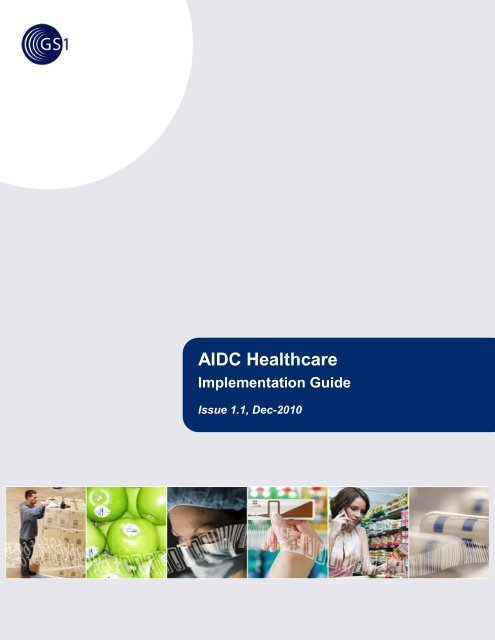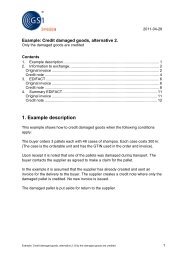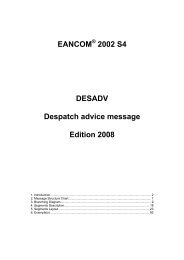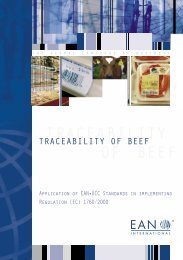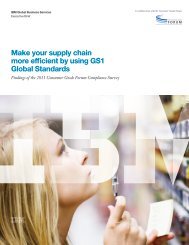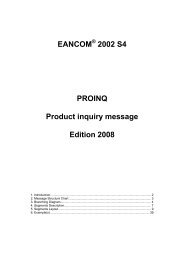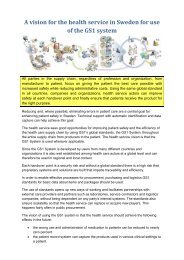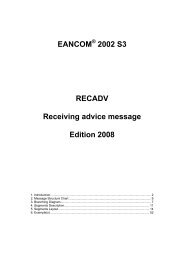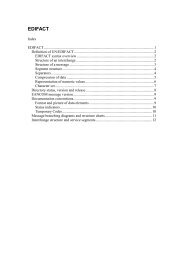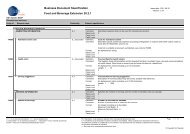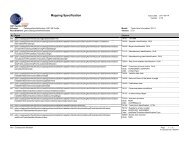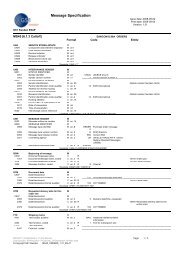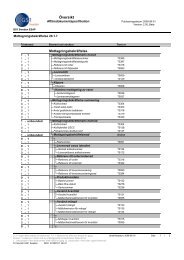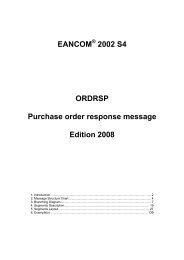AIDC Healthcare Implementation Guide - GS1
AIDC Healthcare Implementation Guide - GS1
AIDC Healthcare Implementation Guide - GS1
Create successful ePaper yourself
Turn your PDF publications into a flip-book with our unique Google optimized e-Paper software.
<strong>AIDC</strong> <strong>Healthcare</strong> <strong>Implementation</strong> <strong>Guide</strong><strong>AIDC</strong> <strong>Healthcare</strong><strong>Implementation</strong> <strong>Guide</strong>Issue 1.1, Dec-2010Issue 1.1, Approved, Dec-2010 All contents copyright © <strong>GS1</strong> Page 1 of 33
<strong>AIDC</strong> <strong>Healthcare</strong> <strong>Implementation</strong> <strong>Guide</strong>Document SummaryDocument ItemDocument TitleDate Last ModifiedCurrent Value<strong>AIDC</strong> <strong>Healthcare</strong> <strong>Implementation</strong> <strong>Guide</strong>Dec-2010Document Issue Issue 1.1Document StatusDocument DescriptionApprovedFor the buying, selling and trading of products and services, organisations need to adhereto standards in their communications with each other. The <strong>GS1</strong> System is a set of standardsthat, through its implementation, facilitates an efficient supply chain worldwide, due touniquely identified products, logistic units and locations. These standards are global,neutral, non-ambiguous and non-significant. They facilitate product and data flow betweensupply chain partners such as suppliers, manufacturers, wholesalers, logistic providers,transporters, hospitals, etc. They help automatic data capture and data management,increase data flow, reduce cost and secure the supply chain.ContributorsNameSprague AckleyPeter AlvarezChuck BissDennis BlackNsimba BlaiseJeff ChanChristy ChenLouis ChingDaniel ClarkBarbara DornerJackie ElkinDawn FowlerClemens HaasNathan HabeckChristine HankoKarolin HarsanjiGary HartleyChristian HayTom HeistTina HoGrant HodgkinsMarcia KafkakisJanice KiteCompanyIntermec Technologies Corp.<strong>GS1</strong> Global Office<strong>GS1</strong> Global OfficeBDCentre Hospitalier de Nantes<strong>GS1</strong> Hong Kong<strong>GS1</strong> Taiwan<strong>GS1</strong> Hong Kong<strong>GS1</strong> Canada<strong>GS1</strong> AustriaMedtronicEdwards LifesciencesFresenius KabiBaxter <strong>Healthcare</strong><strong>GS1</strong> Hungary<strong>GS1</strong> Sweden<strong>GS1</strong> New Zealand<strong>GS1</strong> Switzerland<strong>GS1</strong> Global Office<strong>GS1</strong> Hong KongAlcon LabsBaxter <strong>Healthcare</strong><strong>GS1</strong> Global OfficeIssue 1.1, Approved, Dec-2010 All contents copyright © <strong>GS1</strong> Page 2 of 33
<strong>AIDC</strong> <strong>Healthcare</strong> <strong>Implementation</strong> <strong>Guide</strong>NameCharles KobayashiLewis KontnikUlrike KreysaConser LeeJeff MackayAna Paula ManieroValerie MarchandTim MarshMichael MowadAlice MukaruGiada NecciSilverio Oliveira PaixaoCécile ParentTatiana PeñaJesper PetersenSarina PielaatPimsiri PimaiklangNeil PiperJohn RobertsSue SchmidJeffrey SecundaTania SniochBarry SpellmanAndrew StellonPeter TomickiMark WalchakDani YusdiarVolker ZeinarCompanyRFID Alliance CorporationAmgen Inc.<strong>GS1</strong> Global Office<strong>GS1</strong> Hong KongGE <strong>Healthcare</strong><strong>GS1</strong> Brazil<strong>GS1</strong> FrancePfizer, Inc.<strong>GS1</strong> Global Office<strong>GS1</strong> Sweden<strong>GS1</strong> Italy<strong>GS1</strong> PortugalCH Rene Dubos PONTOISE<strong>GS1</strong> Peru<strong>GS1</strong> Denmark<strong>GS1</strong> Netherlands<strong>GS1</strong> Thailand<strong>GS1</strong> UK<strong>GS1</strong> US<strong>GS1</strong> AustraliaAdvaMed<strong>GS1</strong> Australia<strong>GS1</strong> IrelandBDGE <strong>Healthcare</strong>Pfizer, Inc.<strong>GS1</strong> IndonesiaB. Braun Medical Inc.Log of Changes in Issue 1.1Issue No. Date of Change Changed By Summary of Change1 Dec-2010 Mike Mowad Initial VersionIssue 1.1, Approved, Dec-2010 All contents copyright © <strong>GS1</strong> Page 3 of 33
<strong>AIDC</strong> <strong>Healthcare</strong> <strong>Implementation</strong> <strong>Guide</strong>DisclaimerWhilst every effort has been made to ensure that the guidelines to use the <strong>GS1</strong> standards contained in thedocument are correct, <strong>GS1</strong> and any other party involved in the creation of the document HEREBY STATE thatthe document is provided without warranty, either expressed or implied, of accuracy or fitness for purpose, ANDHEREBY DISCLAIM any liability, direct or indirect, for damages or loss relating to the use of the document. Thedocument may be modified, subject to developments in technology, changes to the standards, or new legalrequirements. Several products and company names mentioned herein may be trademarks and/or registeredtrademarks of their respective companies.Issue 1.1, Approved, Dec-2010 All contents copyright © <strong>GS1</strong> Page 4 of 33
<strong>AIDC</strong> <strong>Healthcare</strong> <strong>Implementation</strong> <strong>Guide</strong>Table of Contents1. Introduction ............................................................................................................................... 71.1. Purpose of this Document ............................................................................................................. 71.2. Who Will Use this Document? ....................................................................................................... 82. Type of Products in Scope........................................................................................................ 92.1. Pharmaceutical Products ............................................................................................................... 92.2. Medical Devices .......................................................................................................................... 103. <strong>Healthcare</strong> Product Marking ................................................................................................... 103.1. Marking for Pharmaceutical Products .......................................................................................... 103.2. Marking for Medical Devices ........................................................................................................ 133.3. <strong>AIDC</strong> Marking Levels ................................................................................................................... 143.3.1. MINIMUM Level of <strong>AIDC</strong> Marking....................................................................................... 143.3.2. ENHANCED Level of <strong>AIDC</strong> Marking ................................................................................... 143.3.3. HIGHEST Level of <strong>AIDC</strong> Marking ....................................................................................... 143.4. Product Configurations ................................................................................................................ 143.4.1. Direct Part Marking (DPM) ................................................................................................. 143.4.2. Primary Package ............................................................................................................... 153.4.3. Secondary Package ........................................................................................................... 163.4.4. Case / Shipper and Pallet................................................................................................... 163.5. Package Hierarchy ...................................................................................................................... 173.6. Distribution Channel .................................................................................................................... 184. <strong>GS1</strong> Identification Keys and Additional Data used in this Document .................................. 184.1. Global Trade Item Number (GTIN)............................................................................................... 184.2. Serial Shipping Container Code (SSCC)...................................................................................... 194.3. Global Returnable Asset Identifier (GRAI).................................................................................... 194.4. Global Individual Asset Identifier (GIAI) ....................................................................................... 194.5. Batch/Lot - AI (10)....................................................................................................................... 194.6. Expiration Date - AI (17).............................................................................................................. 194.7. Expiration Date and Time - AI (7003)........................................................................................... 204.8. Serial Number - AI (21)................................................................................................................ 204.9. Active Potency – AI (7004) .......................................................................................................... 205. <strong>GS1</strong> Data Carriers .................................................................................................................... 205.1. EAN/UPC .................................................................................................................................... 205.2. <strong>GS1</strong>-128 ..................................................................................................................................... 215.3. ITF-14 ......................................................................................................................................... 215.4. <strong>GS1</strong> DataBar............................................................................................................................... 215.5. <strong>GS1</strong> DataMatrix........................................................................................................................... 215.6. Radio Frequency Identification (RFID)......................................................................................... 225.7. Data Carrier Selection ................................................................................................................. 22Issue 1.1, Approved, Dec-2010 All contents copyright © <strong>GS1</strong> Page 5 of 33
<strong>AIDC</strong> <strong>Healthcare</strong> <strong>Implementation</strong> <strong>Guide</strong>6. <strong>Implementation</strong> Procedures.................................................................................................... 226.1. Who will identify a product? ......................................................................................................... 226.2. Practical Steps to Implement GTINs using Bar Codes ................................................................. 226.3. Additional Considerations ............................................................................................................ 257. Use Cases ................................................................................................................................ 257.1. Hospital of Geneva: Cytostatics Identification .............................................................................. 257.2. University Hospital of South Manchester: Identification of Instruments ......................................... 27Appendix A. Glossary .................................................................................................................. 29Appendix B. Supply Chain Roles and Definitions ...................................................................... 31Appendix C. Frequently Asked Questions (FAQ) ....................................................................... 32Issue 1.1, Approved, Dec-2010 All contents copyright © <strong>GS1</strong> Page 6 of 33
<strong>AIDC</strong> <strong>Healthcare</strong> <strong>Implementation</strong> <strong>Guide</strong>1. Introduction<strong>GS1</strong> <strong>Healthcare</strong> is a healthcare-specific, global user group bringing together both large and small<strong>Healthcare</strong> stakeholders: pharmaceutical and medical device suppliers and manufacturers,wholesalers and distributors, group purchasing organizations, hospitals, pharmacies, logisticproviders, governmental and regulatory bodies and industry associations. It was formed in 2007 whenthe <strong>GS1</strong> EPCglobal <strong>Healthcare</strong> and Life Sciences Industry Action Group (HLS) and the <strong>GS1</strong> global<strong>Healthcare</strong> User Group (<strong>GS1</strong> HUG) merged into one global <strong>Healthcare</strong> user group: “<strong>GS1</strong> <strong>Healthcare</strong>”.The vision of <strong>GS1</strong> <strong>Healthcare</strong> is to be the recognized, open and neutral source for regulatoryagencies, industry organizations and other similar stakeholders who are seeking direction for globalstandards in healthcare for patient safety, supply chain security & efficiency, traceability and accuratedata synchronisation. The mission of <strong>GS1</strong> <strong>Healthcare</strong> is to lead the <strong>Healthcare</strong> sector to thesuccessful development and implementation of global standards by bringing together experts in<strong>Healthcare</strong> to enhance patient safety and supply chain efficiencies.Automatic Identification and Data Capture (<strong>AIDC</strong>) Standards for <strong>Healthcare</strong> trade items have beenincorporated within the <strong>GS1</strong> General Specifications. The result is a voluntary standard providing<strong>Healthcare</strong> industry stakeholders with a common set of data and data carriers to be applied to medicalproducts at every packaging level, including specific guidance on selection and use of:■■■Appropriate <strong>GS1</strong> Product Identification KeysAdditional product and production data, for example; lot number, expiration date, and/or serialnumber (where applicable)<strong>GS1</strong> Data Carriers including; linear bar codes, two-dimensional bar codes and Radio FrequencyIdentification (RFID) tagsThe Application Standard for <strong>AIDC</strong> in <strong>Healthcare</strong> was developed to target approximately 80% of the<strong>Healthcare</strong> products currently in the global marketplace. Future efforts will target additional <strong>AIDC</strong>marking needs.These support the ability for sector-wide implementation of <strong>AIDC</strong> systems targeted to improve patientsafety, reduce medication errors, facilitate anti-counterfeiting and enable effective product recalls, andadverse event reporting, while addressing inefficiencies throughout the <strong>Healthcare</strong> supply chain, andallowing stakeholders to improve and integrate their processes.This work was completed over three (3) years by more than 100 experts from every region of the worldand segment of the healthcare supply chain. This involved over 150 meetings (more than 4,500contact hours) as the teams carefully compiled the industry’s business requirements, and designedand delivered the global <strong>GS1</strong> solutions to meet these challenging requirements.With the publishing of these changes in the <strong>GS1</strong> General Specifications, the focus has turned todeveloping this <strong>Implementation</strong> <strong>Guide</strong>line. It is intended to guide the <strong>Healthcare</strong> user through theprocess of implementing the <strong>GS1</strong> System for <strong>AIDC</strong> in <strong>Healthcare</strong>.1.1. Purpose of this DocumentFor the buying, selling and trading of products and services, organisations need to adhere tostandards in their communications with each other. The <strong>GS1</strong> System is a set of standards that,through its implementation, facilitates an efficient supply chain worldwide, due to uniquely identifiedproducts, logistic units and locations. These standards are intended to be global, neutral, and nonambiguous.They facilitate product and data flow between supply chain partners such as suppliers,manufacturers, wholesalers, logistic providers, transporters, hospitals, etc. They help automatic datacapture and data management, increase data flow, reduce cost and secure the supply chain.The <strong>GS1</strong> System uses identification numbers and supplementary data represented in a bar codeformat or in RFID tags to track and trace products in the supply chain. These numbers are alsoIssue 1.1, Approved, Dec-2010 All contents copyright © <strong>GS1</strong> Page 7 of 33
<strong>AIDC</strong> <strong>Healthcare</strong> <strong>Implementation</strong> <strong>Guide</strong>exchanged via electronic messages to be automatically integrated and stored in databases. They arethe key to access a set of information that may be used for traceability.This document is intended to provide guidance to readers for:■■■Using a Global Trade Item Number (GTIN) in a <strong>Healthcare</strong> environmentRecognizing when additional data is required for healthcare trade item identification andtraceabilityInterpreting the various <strong>AIDC</strong> marking requirements for healthcare trade items.This implementation guide does not set or modify <strong>GS1</strong> standards. This guideline is intended to beused in conjunction with applicable <strong>GS1</strong> standards, including but not limited to the:■■■■<strong>GS1</strong> General Specifications (Available from your local <strong>GS1</strong> Member Organisation)<strong>GS1</strong> <strong>Healthcare</strong> GTIN Allocation Rules (www.gs1.org/1/gtinrules)<strong>GS1</strong> Traceability Standard for <strong>Healthcare</strong> (http://www.gs1.org/gsmp/kc/healthcare)<strong>GS1</strong> Global Data Dictionary – GDD (gdd.gs1.org/gdd)Important: This document should not be interpreted as a regulatory guide for the marking oridentification of products. It includes implementation guides for a variety of the morecomplicated issues encountered when implementing the <strong>GS1</strong> standards outlined by thisdocument. It seeks to increase consistency and ease of implementation by explaining the <strong>GS1</strong>standards and providing real-world examples.Note: The reader should refer to the latest published version of these standards when using thisguide.Note: Your local <strong>GS1</strong> Member Organization is the primary contact for additional information andassistance.1.2. Who Will Use this Document?Product identification principles as applied to the products in other industry sectors should beexpanded to account for some unique characteristics in the healthcare sector, such as the riskclassifications assigned to products and the need for products to be identified until point of use orthroughout treatment.This document will be used when an organisation has to define and apply a GTIN and the additionalinformation to facilitate tracing its products throughout the supply chain. Organisations that may findthis document useful include manufacturers, wholesalers, GPOs, distributors, logistic providers,retailers, hospitals and pharmacies.This document is intended for parties within the healthcare supply chain who are responsible for theselection of data and data carriers, the labelling of healthcare products, and parties that scan/read thedata carriers.The healthcare supply chain (Figure 1-1) represents the point of manufacture to end-of-treatmentthroughout the product lifecycle.Issue 1.1, Approved, Dec-2010 All contents copyright © <strong>GS1</strong> Page 8 of 33
<strong>AIDC</strong> <strong>Healthcare</strong> <strong>Implementation</strong> <strong>Guide</strong>Figure 1-1 <strong>Healthcare</strong> Supply Chain2. Type of Products in ScopeThis section identifies example types of products with supplemental descriptions that are addressed inthis document.2.1. Pharmaceutical ProductsThese products are submitted for market authorisation to be sold in a country. Depending on thehealthcare organisation, an authorisation code can be given by a government agency, a <strong>GS1</strong> memberorganisation, or any organisation validated by the ministry of health to allocate this code.In most countries these products can only be sold in a selected distribution channel such aspharmacies and are subject to specific regulations.Over the Counter (OTC)An OTC is a pharmaceutical product, drug, or medicinal specialty whose dispensing or administrationdoes not require medical authorization. Normally it can be used by the consumers under their owninitiative and responsibility to prevent, relieve or to treat symptoms or mild diseases. Its use, in theform, conditions and authorized dosages should be safe for the consumer.This covers healthcare items, pharmaceuticals, and medical devices that do not require a medicalprescription or direct medical intervention. Typical examples include bandages, first-aid kits,mouthwash, low-strength pain-killers, etc.Medical Prescription (Rx)A Medical Prescription Product (Rx) (often referred to as a Pharmaceutical) is a drug or medicinalspecialty that requires a medical prescription or direct medical intervention. Typical examples include,medicated bandages, pain medication, injectables etc and can normally only be obtained with aprescription from an appropriate health care practitioner.Hospital Pharmacy ProductionA Hospital Pharmacy Product is a product that has to be manufactured by a hospital pharmacy forinternal or multi-hospital use, thus it is not (or is no more) marketed by the pharmaceutical companythat supplied the raw material. These products may correspond to the Rx or OTC category. In anycase, they have to be clearly identified from the production to the bedside.Issue 1.1, Approved, Dec-2010 All contents copyright © <strong>GS1</strong> Page 9 of 33
<strong>AIDC</strong> <strong>Healthcare</strong> <strong>Implementation</strong> <strong>Guide</strong>2.2. Medical DevicesMedical device means any instrument, apparatus, implement, machine, appliance, implant, in vitroreagent or calibrator, software, material or other similar or related article, intended by the manufacturerto be used, alone or in combination, for human beings for one or more of the specific purposes of:■■■■■■■Diagnosis, prevention, monitoring, treatment or alleviation of diseaseDiagnosis, monitoring, treatment, alleviation of or compensation for an injuryInvestigation, replacement, modification or support of the anatomy or of a physiologicalprocessSupporting or sustaining lifeControl of conceptionDisinfection of medical devicesProviding information for medical purposes by means of in vitro examination of specimensderived from the human body and which does not achieve its primary intended action in or onthe human body by pharmacological, immunological or metabolic means, but which may beassisted in its function by such means.3. <strong>Healthcare</strong> Product MarkingWhen adopting the <strong>GS1</strong> standards for <strong>Healthcare</strong> product marking consideration should be given tothe following:■■■■<strong>AIDC</strong> Marking LevelsProduct ConfigurationPackage HierarchyDistribution ChannelThe following sections will more fully describe these areas of consideration to be used by theorganization(s) responsible for selection of the <strong>AIDC</strong> marking.Note: All products shown in this implementation guide are intended as examples. Please referto your local regulatory or trading partner requirements for more information.Note: All of the terms used in sections 3.1 and 3.2 are defined in section 3.3.3.1. Marking for Pharmaceutical ProductsThe following flow diagram will assist the reader in visualizing the navigation of <strong>Healthcare</strong> <strong>AIDC</strong>Marking for Pharmaceutical Products. This should be reviewed in conjunction with the <strong>GS1</strong> GeneralSpecifications and the Pharmaceutical Marking Grid (Figure 3-2). It describes the possiblecombinations of data content for <strong>AIDC</strong> marking of <strong>Healthcare</strong> Pharmaceutical trade items.Issue 1.1, Approved, Dec-2010 All contents copyright © <strong>GS1</strong> Page 10 of 33
<strong>AIDC</strong> <strong>Healthcare</strong> <strong>Implementation</strong> <strong>Guide</strong>Figure 3-1 Pharmaceutical Products MarkingPharmaceuticalProductDistributed and/or SoldPrimarily ViaRetail ChannelsDistributed and/or SoldPrimarily ViaNon-Retail ChannelsDistributed and/or Sold ViaRetail and/or Non-RetailChannelsDPMPrimarySecondaryCase/Shipper& PalletPharmaceuticalMarking Grid#DPM-2PharmaceuticalMarking Grid#PP-2PharmaceuticalMarking Grid#SP-2PharmaceuticalMarking Grid#CS-2DPMPrimarySecondaryCase/Shipper& PalletDPMPrimarySecondaryCase/Shipper& PalletPharmaceuticalMarking Grid#DPM-1PharmaceuticalMarking Grid#PP-1PharmaceuticalMarking Grid#SP-1PharmaceuticalMarking Grid#CS-1PharmaceuticalMarking Grid#DPM-3PharmaceuticalMarking Grid#PP-3PharmaceuticalMarking Grid#SP-3PharmaceuticalMarking Grid#CS-3Note:Represented here are generalized examples. Refer to the <strong>GS1</strong> General Specifications fordetails of specific information on data content. Local Regulatory requirements for data carrier,data content, etc. may supersede the information given in the Pharmaceutical Marking Grid(Figure 3-2).Issue 1.1, Approved, Dec-2010 All contents copyright © <strong>GS1</strong> Page 11 of 33
<strong>AIDC</strong> <strong>Healthcare</strong> <strong>Implementation</strong> <strong>Guide</strong>MINIMUM Level of <strong>AIDC</strong> Marking(Retail)Pharmaceuticals Distributed and/or SoldPrimarily Via Retail ChannelsFigure 3-2 Pharmaceutical Marking GridMINIMUM Level of <strong>AIDC</strong> Marking(Non-Retail)Pharmaceuticals Distributed and/or SoldPrimarily Via Non-Retail Channels#DPM-1 #DPM-2 #DPM-3HIGHEST Level of <strong>AIDC</strong> MarkingPharmaceuticals Distributed and/or SoldVia Retail and/or Non-Retail ChannelsDirect PartMarkENCODED DATAManufacturerDistributor / RepackerNo <strong>AIDC</strong> DataDATA CARRIERManufacturerDistributor / RepackerNo <strong>AIDC</strong> CarrierENCODED DATAManufacturerDistributor / RepackerNo <strong>AIDC</strong> DataDATA CARRIERManufacturerDistributor / RepackerNo <strong>AIDC</strong> CarrierENCODED DATAManufacturerDistributor / RepackerNo <strong>AIDC</strong> DataDATA CARRIERManufacturerDistributor / RepackerNo <strong>AIDC</strong> CarrierHospitalNo <strong>AIDC</strong> DataHospitalNo <strong>AIDC</strong> CarrierHospitalNo <strong>AIDC</strong> DataHospitalNo <strong>AIDC</strong> CarrierHospitalNo <strong>AIDC</strong> DataHospitalNo <strong>AIDC</strong> CarrierPrimaryPackage#PP-1 #PP-2 #PP-3ENCODED DATAManufacturerDistributor / RepackerNo <strong>AIDC</strong> DataHospitalNo <strong>AIDC</strong> DataDATA CARRIERManufacturerDistributor / RepackerNo <strong>AIDC</strong> CarrierHospitalNo <strong>AIDC</strong> CarrierENCODED DATAManufacturerDistributor / RepackerGTIN-8; -12; -13; or -14,or EPC SGTIN (if RFID)HospitalNo <strong>AIDC</strong> DataDATA CARRIERManufacturerDistributor / Repacker<strong>GS1</strong>-128, DataBar, DataMatrix, or RFIDHospitalNo <strong>AIDC</strong> Carrier#SP-1 #SP-2 #SP-3ENCODED DATAManufacturerDistributor / RepackerGTIN-8; -12; -13; or -14,or EPC SGTIN (if RFID)HospitalGTIN-8; -12; -13; or -14,+ Serial No. + AI(7003)for short-expiry itemDATA CARRIERManufacturerDistributor / Repacker<strong>GS1</strong>-128, DataBar, DataMatrix, or RFIDHospital<strong>GS1</strong>-128, DataBar, DataMatrix, or RFIDSecondaryPackagingENCODED DATAManufacturerDistributor / RepackerGTIN-8; -12; -13HospitalNo <strong>AIDC</strong> DataDATA CARRIERManufacturerDistributor / RepackerUPC-E, UPC-A, EAN-8,EAN-13, or DataBarHospitalNo <strong>AIDC</strong> CarrierENCODED DATAManufacturerDistributor / RepackerGTIN-8; -12; -13; or -14,+ Lot + Expiry, orEPC SGTIN (if RFID)HospitalNo <strong>AIDC</strong> DataDATA CARRIERManufacturerDistributor / Repacker<strong>GS1</strong>-128, DataBar, DataMatrix, or RFIDHospitalNo <strong>AIDC</strong> Carrier#CS-1 #CS-2 #CS-3ENCODED DATADATA CARRIERManufacturerManufacturerDistributor / Repacker Distributor / Repacker1st Mark: GTIN-8, GTIN-12, or 1st Mark: UPC-E, UPC-A, EAN-GTIN-138, EAN-13, or DataBar2nd Mark:2nd Mark: <strong>GS1</strong>-128, DataBar,GTIN-8; -12; -13; or -14, Data Matrix, or RFID+ Lot + Expiry + Serial No,+ Potency,or EPC SGTIN (if RFID)HospitalGTIN-8; -12; -13; or -14,+ Serial No. + AI(7003)for short-expiry itemHospital<strong>GS1</strong>-128, DataBar,Data Matrix, or RFIDCase /ShipperENCODED DATAManufacturerDistributor / RepackerIf Trade Item:GTIN-8; -12; -13; or -14,+ Lot + Expiry, orEPC SGTIN (if RFID)If Logistics Unit:AI(00) SSCC orEPC SSCC (if RFID)DATA CARRIERManufacturerDistributor / Repacker<strong>GS1</strong>-128, Data Matrix, or RFIDENCODED DATAManufacturerDistributor / RepackerIf Trade Item:GTIN-8; -12; -13; or -14,+ Lot + Expiry, orEPC SGTIN (if RFID)If Logistics Unit:AI(00) SSCC orEPC SSCC (if RFID)DATA CARRIERManufacturerDistributor / Repacker<strong>GS1</strong>-128, Data Matrix, or RFIDENCODED DATAManufacturerDistributor / RepackerIf Trade Item:GTIN-8; -12; -13; or -14,+ Lot + Expiry + Serial No,+ Potency, or EPC SGTIN (ifRFID)If Logistics Unit:AI(00) SSCC orEPC SSCC (if RFID)DATA CARRIERManufacturerDistributor / Repacker<strong>GS1</strong>-128, Data Matrix, or RFIDHospitalNo <strong>AIDC</strong> DataHospitalNo <strong>AIDC</strong> CarrierHospitalNo <strong>AIDC</strong> DataHospitalNo <strong>AIDC</strong> Carrier#P-1 #P-2 #P-3HospitalGTIN-8; -12; -13; or -14,+ Serial No. + AI(7003)for short-expiry itemHospital<strong>GS1</strong>-128, Data Matrix, or RFIDPalletENCODED DATAManufacturerDistributor / RepackerIf Trade Item:GTIN-8; -12; -13; or -14,+ Lot + Expiry, orEPC SGTIN (if RFID)DATA CARRIERManufacturerDistributor / Repacker<strong>GS1</strong>-128, or RFIDENCODED DATAManufacturerDistributor / RepackerIf Trade Item:GTIN-8; -12; -13; or -14,+ Lot + Expiry, or EPC SGTIN(if RFID)DATA CARRIERManufacturerDistributor / Repacker<strong>GS1</strong>-128 or RFIDENCODED DATAManufacturerDistributor / RepackerIf Trade Item:GTIN-8; -12; -13; or -14,+ Lot + Expiry + Serial No,or EPC SGTIN (if RFID)DATA CARRIERManufacturerDistributor / Repacker<strong>GS1</strong>-128 or RFIDIf Logistics Unit:AI(00) SSCC, or EPC SSCC(if RFID)If Logistics Unit:AI(00) SSCC, or EPC SSCC(if RFID)If Logistics Unit:AI(00) SSCC, or EPC SSCC(if RFID)HospitalNo <strong>AIDC</strong> DataHospitalNo <strong>AIDC</strong> CarrierHospitalNo <strong>AIDC</strong> DataHospitalNo <strong>AIDC</strong> CarrierHospitalNo <strong>AIDC</strong> DataHospitalNo <strong>AIDC</strong> CarrierIssue 1.1, Approved, Dec-2010 All contents copyright © <strong>GS1</strong> Page 12 of 33
<strong>AIDC</strong> <strong>Healthcare</strong> <strong>Implementation</strong> <strong>Guide</strong>3.2. Marking for Medical DevicesWhen the <strong>AIDC</strong> marking of Medical Devices is required, the following flow diagram will assist thereader in visualizing the navigation of <strong>Healthcare</strong> Marking for Medical Devices. This should bereviewed in conjunction with the <strong>GS1</strong> General Specifications. Not all Medical Device trade items mayrequire <strong>AIDC</strong> marking, as defined by regulations and/or manufacturers’ processes.StartFigure 3-3 Medical Devices MarkingIs Trade Itempackaged?NoDirect Part Marking(Marked with “DI” asminimum)YesIs Trade Itema “Reusable”Product?NoYesDirect Part Marking(Marked with “DI” asminimum)Is the LowestPackaging Levelto be marked?NoMark all HigherPackaging Levels(Marked with “DI” + “PI”)YesMark lowest PackagingLevel (Marked with “DI”as Minimum)EndNote: In all instances, the reader should refer to the appropriate Trade Item ApplicationSpecification section of the <strong>GS1</strong> General Specifications should be referred to for detailedinformation and guidance on <strong>AIDC</strong> Marking.For the purpose of this document and its related application:■■■“Device/Drug Identifier”, “DI” as indicated in the Decision Tree, is the identifier for the tradeitem and is at a minimum, the Global Trade Item Number (GTIN).“Production Identifier(s)”, “PI” as indicated in the Decision Tree, are Expiry Date, Batch / LotNumbers and/or Serial Numbers used for product traceability. In applying “ProductionIdentifiers” it is the brand owner / manufacturer‘s decision whether a product is lot or serialnumber controlled.Instances noted above of “DI” only indicate “MINMUM Level of <strong>AIDC</strong> Marking” and instancesnoted above of “DI” + “PI” indicate ENHANCED and HIGHEST Levels of <strong>AIDC</strong> Marking”. Asthe “MINIMUM Level of <strong>AIDC</strong> Marking” may in some cases include no <strong>AIDC</strong> marking as anIssue 1.1, Approved, Dec-2010 All contents copyright © <strong>GS1</strong> Page 13 of 33
<strong>AIDC</strong> <strong>Healthcare</strong> <strong>Implementation</strong> <strong>Guide</strong>■■option, the appropriate Trade Item Application Specification section of the <strong>GS1</strong> GeneralSpecifications should be referred to for detailed information and guidance about requirementsand options.“Direct Part Marking” can be realized by various technologies that leave a permanent mark.Technical and practical feasibility of using a marking technology at the respective pack level(or direct on the product itself) is a prerequisite (e.g. sufficient space, substrate or packagingmaterial suitability, etc.).3.3. <strong>AIDC</strong> Marking LevelsThe <strong>AIDC</strong> marking of healthcare products uses a graduated system of marking; Minimum, Enhancedand Highest. The identification solution for each of these levels may differ between the category of“pharmaceuticals” (which includes biologics, vaccines, controlled substances, clinical trialpharmaceuticals and therapeutic nutritional products) versus the category of “medical devices” (whichincludes all classes of medical devices) and may also differ by configuration or packaging level (tradeitems direct marked, primary packaging, secondary packaging, case/shipper, pallet, logistics unit).Consideration should first be given to the data to be included in the data carrier. Decisions will takeinto account different levels of <strong>AIDC</strong> Marking. The three levels of <strong>AIDC</strong> Marking are designatedMinimum, Enhanced and Highest based on information need.3.3.1. MINIMUM Level of <strong>AIDC</strong> MarkingA level within a graduated system of <strong>AIDC</strong> trade item marking that provides a GTIN with no attributeinformation; it is used with products that do not require a high level of traceability control. Marking atthis level includes the GTIN at a minimum.3.3.2. ENHANCED Level of <strong>AIDC</strong> MarkingA level within a graduated system of <strong>AIDC</strong> trade item marking, it provides GTIN plus attributeinformation. This includes products that require a higher level of traceability control. Marking at thislevel includes the GTIN, Batch or Lot Control Numbers, and the Expiration Date (when applicable).3.3.3. HIGHEST Level of <strong>AIDC</strong> MarkingA level within a graduated system of <strong>AIDC</strong> trade item marking, it provides GTIN, serialization, andpotentially other attribute information. This includes products that require the highest level oftraceability control. Marking at this level includes a GTIN, Serial Number and Expiration Date (whenapplicable).3.4. Product ConfigurationsConsideration should next be given to where on the product the data will be carried. Decisions willtake into account different levels of product configuration.3.4.1. Direct Part Marking (DPM)Direct part marking (DPM) refers to a process of marking a symbol directly onto an item withoutpackaging using an intrusive or non-intrusive method instead of applying a label or using anotherindirect marking process.Issue 1.1, Approved, Dec-2010 All contents copyright © <strong>GS1</strong> Page 14 of 33
<strong>AIDC</strong> <strong>Healthcare</strong> <strong>Implementation</strong> <strong>Guide</strong>Figure 3-4 Example Direct Part Marking3.4.2. Primary PackageThe primary package is the first level of packaging for the product marked with a data carrier either onthe packaging or on a label affixed to the packaging.Primary package configurations may consist of:■■■■■sterile packagingnon-sterile packagingsingle itemgroup of itemscombination of items for a single therapy (kit)Figure 3-5 Primary Package examples:Figure 3-6 Kit exampleIssue 1.1, Approved, Dec-2010 All contents copyright © <strong>GS1</strong> Page 15 of 33
<strong>AIDC</strong> <strong>Healthcare</strong> <strong>Implementation</strong> <strong>Guide</strong>3.4.3. Secondary PackageSecondary packaging configurations consist of packages containing one or more single items in theirPrimary PackagingFigure 3-7 Secondary Package examples:3.4.4. Case / Shipper and PalletThese are packaging configurations that may be used as either trade items or logistic units. Case /shippers may contain one or more items in their Primary Packaging and/or Secondary Packaging.Pallets may contain one or more case / shippers.Note: Only fixed configuration Pallets and Shippers may be identified with a GTIN.Figure 3-8 Case / Shipper ExampleFigure 3-9 Pallet ExampleIssue 1.1, Approved, Dec-2010 All contents copyright © <strong>GS1</strong> Page 16 of 33
<strong>AIDC</strong> <strong>Healthcare</strong> <strong>Implementation</strong> <strong>Guide</strong>3.5. Package HierarchyConsideration should be given to the hierarchy of packaging. Each level of the package hierarchypresents different printing challenges in labelling (e.g. space, substrate, production line speed, etc.).Each level also presents differing data information requirements: <strong>GS1</strong> Identification Key or <strong>GS1</strong>Identification Key plus additional data.The <strong>GS1</strong> System provides a variety of Data Carriers that will meet the combination of printing and dataneeds. This section will offer illustrations and examples.Figure 3-10 Package Hierarchy IllustrationNote: Pallets can be marked with either GTIN (following <strong>GS1</strong> <strong>Healthcare</strong> GTIN AllocationRules) or Serial Shipping Container Code (SSCC) identifiers (which is defined in Section 4.2).Table 3-1 provides examples of the different symbologies, coding options and information attributes foreach packaging level and the associated label size.Table 3-1 Package Hierarchy Examples<strong>Healthcare</strong> Product <strong>GS1</strong> Key * AdditionaldataEncoded information and <strong>GS1</strong> Data CarriersPrimary packaging(one pill in the blistercell)GTIN “1”Lot ABCExpiry date31-Dec-2010(01)07665431234566(17)101231(10)ABCSuggested <strong>GS1</strong> Data Carriers: <strong>GS1</strong>DataMatrix, <strong>GS1</strong> DataBaror(01)07665431234566Suggested <strong>GS1</strong> Data Carriers: <strong>GS1</strong>DataMatrix, <strong>GS1</strong> DataBarSecondarypackaging**(two blisters in onebox)GTIN “2”Lot ABCExpiry date31-Dec-2010(01) 07665433456781(17)101231(10)ABCSuggested <strong>GS1</strong> Data Carriers:<strong>GS1</strong>DataMatrix, <strong>GS1</strong>-128, <strong>GS1</strong> DataBarMulti-pack(7 boxes)This is only anexample of anotherpackaging levelGTIN “3”Lot ABCExpiry date31-Dec-2010(01)07665431234887(17)101231(10)ABCor(01)17665431234563(17)101231(10)ABCSuggested <strong>GS1</strong> Data Carriers:<strong>GS1</strong>DataMatrix, <strong>GS1</strong>-128, <strong>GS1</strong> DataBarIssue 1.1, Approved, Dec-2010 All contents copyright © <strong>GS1</strong> Page 17 of 33
<strong>AIDC</strong> <strong>Healthcare</strong> <strong>Implementation</strong> <strong>Guide</strong><strong>Healthcare</strong> Product <strong>GS1</strong> Key * AdditionaldataEncoded information and <strong>GS1</strong> Data CarriersCase(8 multi-packs)GTIN “4”Lot ABCExpiry date31-Dec-2010(01)07665431234573(17)101231(10)ABCor(01)27665431234560(17)101231(10)ABCSuggested <strong>GS1</strong> Data Carriers:<strong>GS1</strong>-128, <strong>GS1</strong>DataMatrix* For information on <strong>GS1</strong> Keys refer to the <strong>GS1</strong> General Specifications.** Secondary Packages in some countries is sold through retail point of sale (refer to Figure 3-2).Note: Regulatory requirements may specify the data carrier(s) to be used. As these examplesdo not cover all possible scenarios, please refer to the <strong>GS1</strong> General Specifications for moredetailed information.3.6. Distribution ChannelConsideration should be given to the channel (such as Retail Point-of-Sale) through which theproducts are intended to be distributed to aid in the selection of the data and data carrier. A productmay belong in more than one channel depending on the target market(s). Please refer to the <strong>GS1</strong>General Specifications more information on distribution channels and target markets.Note: Specific sectors have requirements or restrictions with regards to the symbologies thatmay be deployed (e.g. Retail Point-of-Sale).4. <strong>GS1</strong> Identification Keys and Additional Data used inthis DocumentWhen marking <strong>Healthcare</strong> products, <strong>GS1</strong> Identification Keys are used to identify trade items andlogistic units. Additional data may be associated with the <strong>GS1</strong> Identification Keys through the use of<strong>GS1</strong> Application Identifiers (AI’s). Following are the <strong>GS1</strong> Identification Keys and Application Identifiersthat are contained in the <strong>GS1</strong> General Specifications for use in <strong>Healthcare</strong> <strong>AIDC</strong> applications. It is nota requirement to use multiple forms of product identification (GTIN, Global Returnable Asset Identifier(GRAI), etc.) on the same package.Note: The Identification Keys which are shown in this section are examples of what are typicallyused in the <strong>Healthcare</strong> industry, other types of Identification Keys may be used.Note: Refer to the <strong>GS1</strong> Global Data Dictionary for the latest approved definitions.4.1. Global Trade Item Number (GTIN)The <strong>GS1</strong> Key for unique product identification is the Global Trade Item Number (GTIN) which isassigned AI (01). GTINs are used to identify “trade items” (i.e., products and services that may bepriced, ordered or invoiced at any point in the supply chain). They are assigned by the brand ownerwho is normally responsible for the allocation of the GTIN.Issue 1.1, Approved, Dec-2010 All contents copyright © <strong>GS1</strong> Page 18 of 33
<strong>AIDC</strong> <strong>Healthcare</strong> <strong>Implementation</strong> <strong>Guide</strong>A company receives a <strong>GS1</strong> Company Prefix by joining a <strong>GS1</strong> Member Organization. This gives thecompany the ability to create GTINs and access to the <strong>GS1</strong> standards.Note: Refer to the <strong>GS1</strong> General Specifications and <strong>GS1</strong> <strong>Healthcare</strong> GTIN Allocation Rules(www.gs1.org/1/gtinrules) for the GTIN Structure.4.2. Serial Shipping Container Code (SSCC)The <strong>GS1</strong> Key for uniquely identifying a logistic unit is the SSCC, which is assigned AI (00). The SSCCcan provide a link between the physical logistic unit and information pertaining to the logistic unit thatis communicated between trading partners using Electronic Data Interchange (EDI).Note: Refer to <strong>GS1</strong> General Specifications for the SSCC structure and rules of use.4.3. Global Returnable Asset Identifier (GRAI)The <strong>GS1</strong> Key for uniquely identifying returnable assets is the GRAI which is assigned AI (8003).GRAIs identify reusable packages or transport equipment of a certain value, such as a tote, a gascylinder, or cold chain container. The GRAI enables tracking as well as recording of relevant data. AGRAI can be used to identify identical returnable assets (as an asset type) and when paired with anoptional serial number can be used to uniquely identify individual assets within that asset type.Note: Refer to the <strong>GS1</strong> General Specifications for the GRAI Structure4.4. Global Individual Asset Identifier (GIAI)The <strong>GS1</strong> Key for uniquely identifying individual assets is the GIAI, which is assigned AI (8004). TheGIAI enables tracking as well as recording of relevant data.Note: Refer to <strong>GS1</strong> General Specifications for the GIAI StructureNote: Refer to the <strong>GS1</strong> Global Data Dictionary for the latest approved definition4.5. Batch/Lot - AI (10)If you require additional data to identify Batch or Lot Number, the <strong>GS1</strong> Application Identifier (10) isused and typically assigned at the point of manufacture. This additional data is alphanumeric with avariable length of up to 20 characters.4.6. Expiration Date - AI (17)If you require additional data to identify an Expiration Date the <strong>GS1</strong> Application Identifier (17) (oftenreferred to as expiry date, use by date or maximum durability date) is used. This indicates the limit ofconsumption or use of a product (e.g., for pharmaceutical products it can indicate the possibility of anindirect health risk resulting from the ineffectiveness of the product after the date). It is expressed asyear, month and day (YYMMDD).Note: The Expiration Date data string can only specify dates within a certain range. Pleaserefer to the <strong>GS1</strong> General Specifications for additional information on structure and range.Issue 1.1, Approved, Dec-2010 All contents copyright © <strong>GS1</strong> Page 19 of 33
<strong>AIDC</strong> <strong>Healthcare</strong> <strong>Implementation</strong> <strong>Guide</strong>4.7. Expiration Date and Time - AI (7003)When the exact expiration date and time is critical to patient safety, the Application Identifier (7003) isused. Date is expressed as year, month and day (YYMMDD) and time is expressed in hours andminutes (HHMM). Examples might be customized pharmaceuticals in a hospital or public pharmacywith an expiration time within a single day.Note: The Expiration Date and Time data string can only specify dates within a certain range.Please refer to the <strong>GS1</strong> General Specifications for additional information on structure andrange.4.8. Serial Number - AI (21)If <strong>Healthcare</strong> products are to be individually tracked and traced using a Serial Number, ApplicationIdentifier (21) can be used. This additional data is alphanumeric with a variable length of up to 20characters.4.9. Active Potency – AI (7004)If use of a <strong>Healthcare</strong> product requires recording of active potency, then AI (7004) can be used toindicate that the additional data field contains an active potency. The active potency of certainbiologics, such as haemophilia products, varies by batch from the nominal potency of the trade itemand is measured in International Units (IUs).Note: Refer to <strong>GS1</strong> General Specifications for more information about Active Potency5. <strong>GS1</strong> Data CarriersThe <strong>Healthcare</strong> specific sections of the <strong>GS1</strong> General Specifications refer to the following data carriers.Note: The following examples were chosen to represent the <strong>Healthcare</strong> industry and may notbe applicable to all industries (see the <strong>GS1</strong> <strong>Healthcare</strong> Marking Decision Tree in section 3).Refer to <strong>GS1</strong> General Specifications for more information on <strong>GS1</strong> symbologies.Note: The following examples are not meant to be all inclusive of the various forms and formatsthat the encoded data may take in the data carriers shown (e.g. a data string which containsGTIN plus attribute data in a <strong>GS1</strong>-128 may be encoded as a single symbol or multiple symbols).5.1. EAN/UPCUPC-A, UPC-E, EAN-13, and EAN-8 Bar Codes can be read omni-directionally. These symbolsshould be used for all items that are scanned at the Point-of-Sale.Figure 5-1 EAN-13 (example of EAN/UPC Symbology)>Issue 1.1, Approved, Dec-2010 All contents copyright © <strong>GS1</strong> Page 20 of 33
<strong>AIDC</strong> <strong>Healthcare</strong> <strong>Implementation</strong> <strong>Guide</strong>5.2. <strong>GS1</strong>-128A subset of the Code 128 Bar Code Symbology, its use is exclusively licensed to <strong>GS1</strong>. This extremelyflexible symbology encodes Element Strings using Application Identifiers.Figure 5-2 <strong>GS1</strong>-128 Bar Code Symbol Example5.3. ITF-14A specific application of the Interleaved 2 of 5 bar code symbology, ITF-14 symbols carry ID numbers onlyon trade items that are not expected to pass through the Point-of-Sale. ITF-14 Symbols are better suitedfor direct printing onto corrugated fibreboard.Figure 5-3 Bar Code Symbol example5.4. <strong>GS1</strong> DataBarA family of linear symbologies used within the <strong>GS1</strong> System. In most cases this family implicitlyencodes the GTIN in Application Identifier (01) and in the case of <strong>GS1</strong> DataBar Expanded explicitlyencodes Element Strings using Application Identifiers.Figure 5-4 <strong>GS1</strong> DataBar Limited example(01)150123456789075.5. <strong>GS1</strong> DataMatrixA two-dimensional bar code symbol that supports <strong>GS1</strong> System data structures, including the Function1 Symbol Character. <strong>Implementation</strong> of <strong>GS1</strong> DataMatrix should be done as per the approved <strong>GS1</strong>System application guidelines. This extremely flexible symbology encodes Element Strings usingApplication Identifiers.Figure 5-5 <strong>GS1</strong> DataMatrix exampleIssue 1.1, Approved, Dec-2010 All contents copyright © <strong>GS1</strong> Page 21 of 33
<strong>AIDC</strong> <strong>Healthcare</strong> <strong>Implementation</strong> <strong>Guide</strong>5.6. Radio Frequency Identification (RFID)Radio-frequency identification (RFID) is the use of a RFID tag applied to or incorporated into a productor item for the purpose of identification and tracking using radio waves. Radio-frequency identificationcomprises interrogators (also known as readers), and tags (also known as labels) and a computernetwork. At present, RFID as a data carrier is not recommended for <strong>Healthcare</strong> product identification.EPC is <strong>GS1</strong>’s standard for RFID applications. For more information please refer to the <strong>GS1</strong> GeneralSpecifications, or EPCglobal Standards documentation at: http://www.gs1.org/gsmp/kc/epcglobal.Figure 5-6 Radio Frequency Identification (RFID) illustration5.7. Data Carrier SelectionSelection of the appropriate <strong>GS1</strong> Data Carrier is based in part upon the trade item to be marked andits use within the supply chain. For assistance in selecting the proper <strong>GS1</strong> Data Carrier refer to the<strong>GS1</strong> Symbology Operational Environment Decision Tree found in the <strong>GS1</strong> General Specifications.6. <strong>Implementation</strong> Procedures6.1. Who will identify a product?Management of product identification is the responsibility of the person or persons within thehealthcare supply chain who are responsible for the <strong>AIDC</strong> marking of healthcare products, assets and/ or logistics units, such as:■■■■■ManufacturerWholesaler / Distributor / Re-packagerGPOsLogistics providersHospital / Pharmacy6.2. Practical Steps to Implement GTINs using Bar CodesThe following steps are informative in nature and intended to help new implementations. Review theseto see how they apply to your organisation and your existing implementation of <strong>GS1</strong> standards.Before a GTIN implementation project is commissioned, executive support will be necessary. Astatement of work should be developed to clearly describe the purpose, scope, goals, objectives,deliverables, and cost of implementation. An important consideration should be the analysis of thecurrent master data, including the development of rules for configuration management and interchangeability.The GTIN will need to be mapped to the master data in a logical standardized fashion.Master data should be cleaned before GTIN assignment. Corporate standards and policy should bedeveloped to regulate how the organization will allocate GTINs moving forward and at what phase ofproduct development lifecycle they get assigned. Systems for allocation of the GTIN (e.g. EnterpriseIssue 1.1, Approved, Dec-2010 All contents copyright © <strong>GS1</strong> Page 22 of 33
<strong>AIDC</strong> <strong>Healthcare</strong> <strong>Implementation</strong> <strong>Guide</strong>Resource Planning or ERP) and governance of master data creation are essential to ensure GTINallocation is in accordance with the <strong>GS1</strong> System.Step 1: Commission a Project□□□□□Scope which products will be identified and bar codedCreate a project team including a Manufacturing, Finance, Engineering, Logistics, Quality,Information Technology, Regulatory and other departments as appropriateLook at the time scales involvedLook into existing bar code production capabilitiesAnalyze how you currently identify productsStep 2: Engage with <strong>GS1</strong>Are you already a member of <strong>GS1</strong>?If you are already a member you should identify which products have already been allocated a<strong>GS1</strong> GTIN. If there are multiple company prefixes from one or more countries, it is the brandowner’s responsibility to manage and use the company prefixes appropriately or according tocompany strategy - or consult one of your local <strong>GS1</strong> organisation for guidance.Not a member of <strong>GS1</strong>?If you are not a member of <strong>GS1</strong>, you will need to join your local <strong>GS1</strong> Member Organisation(membership policies are detailed in <strong>GS1</strong> Operational Manual - available through local <strong>GS1</strong> MOs).Once you have joined, you will be provided with a <strong>GS1</strong> company prefix. This will allow you tocreate Global Trade Item Numbers (GTINs), Serial Shipping Container Codes (SSCC), GlobalLocation Numbers (GLNs) and other <strong>GS1</strong> Identification Keys.The complete identification number you create is a non-significant number, which means that theindividual digits in the number do not relate to any classification or convey any specificinformation. The simplest way to allocate your numbers is sequentially.Step 3: Product CommitmentIdentify which products you wish to allocate GTINs. This product range may be impacted by targetmarkets or discontinued items. Special care must be taken to ensure that all possibleconfigurations be considered prior to allocations of a unique identifier (GTIN).Step 4: Allocate GTINs according to the <strong>GS1</strong> <strong>Healthcare</strong> GTIN Allocation RulesTo manage your GTIN’s accurately you should undertake the following:□□□□□Allocate a unique Global Trade Item Number (GTIN) for each product and for eachpackaging level, referring to the <strong>GS1</strong> <strong>Healthcare</strong> GTIN Allocation Rules(www.gs1.org/1/gtinrules).Register the GTINs in a database linking the number to the product name, description andits hierarchy.The GTIN should never be duplicated or re-used even if the product becomes obsolete.Build in a quality process for GTIN allocation for new products to ensure that duplicationdoes not occur.Build an automatic check digit calculator into your system.Issue 1.1, Approved, Dec-2010 All contents copyright © <strong>GS1</strong> Page 23 of 33
<strong>AIDC</strong> <strong>Healthcare</strong> <strong>Implementation</strong> <strong>Guide</strong>Step 5: Define Product MarkingThe information that will be carried in the bar code and the type of symbology is determined by anumber of factors. The following questions can be used in determining the information that shouldbe carried in the bar code.Use the information in Section 3 and answer the following questions to guide you in marking<strong>Healthcare</strong> products.□□What is the distribution channel for each product? Will the product cross the retail point-ofsale?Define the marking depending on product risk level, the target market, the regulatoryrequirements and customer expectations. Ask your local regulatory staff to provide guidance.Beside product identification (GTIN), is additional information (lot number, expiry date,etc.) required?Step 6: Select Carrier(s) as appropriateIf the product is going to be sold at retail point-of-sale or is going to be used in a roboticdispensing system you will need to choose one of the <strong>GS1</strong> bar code displayed in section 5. Bydoing this consider the target market and the customer’s expectations.Depending on the available space on the product, existing regulations and customer’srequirements, you will choose either a linear bar code or 2D symbol.Step 7: Implement□□Evaluate printing software and devicesWhen choosing or using existing printer software, check your ability to produce your selected<strong>GS1</strong> symbol(s) in accordance with the <strong>GS1</strong> General Specifications.The position of the bar code on the packaging will need to be checked to see that it meets therequirements of the <strong>GS1</strong> General Specifications. Any final labelling or wrapping should also beexamined to ensure that the bar codes remain visible and able to be scanned.Evaluate your symbol qualityIt is good practice to assign the role of Symbol Quality Manager in your organization (andcreate an internal bar code verification process that includes the equipment and techniques totest in accordance with ISO/IEC 15415 and 15416) to ensure your bar codes consistentlymeet the quality standards as specified in the <strong>GS1</strong> General Specifications.In first stages, your code can be checked by your local <strong>GS1</strong> Member Organisation; this canlater be done with a bar code verifier, which is used to check the quality of the symbolsprinted. In case of in-line printing a continuous quality control process is recommended.Note: Unit package markings introduce technical challenges that may not allow printing assmall as the <strong>GS1</strong> General Specifications permits.Step 8: CommunicateCommunicate to the relevant parties (i.e. trading partners, regulators, etc.) your productidentification plans (i.e. new labelling, data carrier, data content, etc.).Issue 1.1, Approved, Dec-2010 All contents copyright © <strong>GS1</strong> Page 24 of 33
<strong>AIDC</strong> <strong>Healthcare</strong> <strong>Implementation</strong> <strong>Guide</strong>6.3. Additional ConsiderationsIn some instances, it may be necessary to perform a Technical Feasibility Study before implementingGTINs within your business. This could include one or more of the following steps■■■■■Is the packaging material suitable to carry a bar code (particularly at single use medicaldevice on primary pack level)?Are artwork changes necessary to support additional information in a bar code symbol?What is the correct size of the bar code that could be used (can depend upon factors such aspackage type, available space, print method, symbology, type of validated ink, etc.)?What is the impact on the production/packaging throughput?Are we meeting Quality System and Regulatory requirements? – All quality systemrequirements and processes should be considered in the implementation.7. Use Cases7.1. Hospital of Geneva: Cytostatics IdentificationItemsAnswerName of organisationHôpitaux Universitaires de GenèveTypeUniversity HospitalNumber of beds 1900Number of FTE medical staff 6241Number of FTE of non-medical staff 2108Pilot / <strong>Implementation</strong><strong>Implementation</strong>Contact (Project lead)Prof. Pascal BonnabryDomain of implementationPharmacy, manufacturing and administration of oncology productsDepartmentPharmacyProductsCytostaticsProject descriptionIntegration of drug administration in daily processesHard- and Software usedNice ID-Gen, Cyto-Admin (in-house software). Lap-tops and wiredimage scanners.Standards and carriers<strong>GS1</strong> System, <strong>GS1</strong> DataMatrixMajor objective, visionObjective is to secure full traceability of drugs down to theadministration to the patient.An initial trial has been made with RFID 13.56 MHz tags, butdemonstrated the limited benefit of RFID.Initially, PDAs have been used. Wireless connection was more difficultto stabilise with this small hardware, therefore mobile Lap-tops havebeen preferred.Volumetric -Project scope global or local? Local scope; a phased implementation of <strong>GS1</strong> tools in the hospitals.Expected ROIROI was not a primary target. See presentation.ROI budget / quality / technical / See presentationregulatory / auditingIssue 1.1, Approved, Dec-2010 All contents copyright © <strong>GS1</strong> Page 25 of 33
<strong>AIDC</strong> <strong>Healthcare</strong> <strong>Implementation</strong> <strong>Guide</strong>ItemsShort term (12-18 months)Long term (+18 months)AnswerProject launch 2005Project end 2007<strong>Implementation</strong> start 2007Project team Y/NStaffing of project teamRole of external project team staffCost of project : monetary, humanresources, ICTDifference to budget (monetary)YesRepresentatives of pharmacy, support, nursing directory, medicalinformatics, <strong>GS1</strong>Technical coaching.n/an/aDifferences to objectives / vision Difficulties occurred with RFID and with Wireless connections.RFID has been replaced by <strong>GS1</strong> DataMatrix. Difficulties with Wirelessconnection stability have been overcome by using laptops instead ofPDA.Sources of differences -Is project included in Organisation’s Nodevelopment planDetail of phases : initialisation /installation / roll out / deploymentWhat slowed down the projectKey for successPre-requisite for deployment -Presentation availableYesConclusionAdvises for similar projectsModelisation of new processes; modification of existing programs,tendering and development of software to produce <strong>GS1</strong> data structuresand bar code images ; tests with users ; tests « in vitro » ; small scaleroll out, deployment.Difficulties around RFIDNurses have been enthusiasticA good base for expanding to other product groups (narcotics, bloodderivatives, etc.)Users (nurses) support is key to progress.Figure 7-1 Cytostatics IdentificationIssue 1.1, Approved, Dec-2010 All contents copyright © <strong>GS1</strong> Page 26 of 33
<strong>AIDC</strong> <strong>Healthcare</strong> <strong>Implementation</strong> <strong>Guide</strong>7.2. University Hospital of South Manchester: Identification ofInstrumentsItemsCompany NameCompany typeNumber of employeesNumber of active item referencesNumber of items following the <strong>GS1</strong>standardsExperience(reflection, pilot, realisation, …)Contact Name (local ProjectManager)Concerned ActivityConcerned MarketProducts / InstrumentsMain Objective / motivation for thatexperience of activityDescriptionInternal item code all levels withGTIN associated to the differentlevelsCode generationOrders takingProduction transfer to distributionSoftware and MaterialStandards and supports usedReponsesUniversity Hospital of South ManchesterNHS <strong>Healthcare</strong> Hospital81 within the CSSD department, 5,200 within the hospital40,000 are being scanned100% (instrumentation apart) Those outside the 100% are the singleuse instruments where the marking is on the packaging not theinstruments.Traceability and marking have been an everyday concern for yearsRealisation phaseProactivelyCaroline Robinson – Customer Contract ManagerMedical DevicesHospitals40,000 being scanned single use productsPatient safety & general cost benefits.The central Data Base department in Derby UK contains certain <strong>GS1</strong>company codes. They open these code in “TrakStar for automaticgeneration of the item codes by the local departmentMarketing asks for the GTIN per instrument, tray, trolley) at the itemcreation. All item are codified where possible before being distributedCustomers can receive orders with Synergy internal code, GTIN;Currently the delivery notes bear the internal Synergy codes.A product is marked with the GTIN where needed and is taken out of theproduction line to carry out this process.GTIN, Expiry Date, Batch Number are immediately entered / registeredin TrakStar for Distribution (<strong>GS1</strong>-128 bar code)TrakStar is the central ERP used by allSynergy generic printer is the IT label generatorWe can have automatic printers at production levels<strong>GS1</strong> System : EAN-13 on tray, <strong>GS1</strong>-128 on single use, <strong>GS1</strong> DataMatrixon instruments, (GTIN & GIAI)Issue 1.1, Approved, Dec-2010 All contents copyright © <strong>GS1</strong> Page 27 of 33
<strong>AIDC</strong> <strong>Healthcare</strong> <strong>Implementation</strong> <strong>Guide</strong>Items<strong>Implementation</strong> of DataMatrixCompany NameCompany typeNumber of employeesNumber of active item referencesNumber of items following the <strong>GS1</strong>standardsExperience(reflection, pilot, realisation, …)Contact Name (local ProjectManager)Concerned ActivityConcerned MarketProducts / InstrumentsMain Objective / motivation for thatexperience of activityDescriptionInternal item code all levels withGTIN associated to the differentlevelsCode generationOrders takingProduction transfer to distributionSoftware and MaterialReponsesMarking data for Data Matrix implementation:Decision taking delay : About 6 monthsPrompter: Official decision making in University Hospital of SouthManchester to get all instruments marked with a GTIN inserted using adata matrix was Director of Estates and Facilities (TrustDecontamination Lead)Flows and traceability optimisationStarting date: May 2007End planned date : Nov 2007 but ongoing due to new lines beingphased into production.Marking technique : thermo transfer or inkjet directly on the productionlinesUniversity Hospital of South ManchesterNHS <strong>Healthcare</strong> Hospital81 within the CSSD department, 5,200 within the hospital40,000 are being scanned100% (instrumentation apart) Those outside the 100% are the singleuse instruments where the marking is on the packaging not theinstruments.Traceability and marking have been an everyday concern for yearsRealisation phaseProactivelyCaroline Robinson – Customer Contract ManagerMedical DevicesHospitals40,000 being scanned single use productsPatient safety & general cost benefits.The central Data Base department in Derby UK contains certain <strong>GS1</strong>company codes. They open these code in “TrakStar for automaticgeneration of the item codes by the local departmentMarketing asks for the GTIN per instrument, tray, trolley) at the itemcreation. All item are codified where possible before being distributedCustomers can receive orders with Synergy internal code, GTIN;Currently the delivery notes bear the internal Synergy codes.A product is marked with the GTIN where needed and is taken out of theproduction line to carry out this process.GTIN, Expiry Date, Batch Number are immediately entered / registeredin TrakStar for Distribution (<strong>GS1</strong>-128 bar code)TrakStar is the central ERP used by allSynergy generic printer is the IT label generatorWe can have automatic printers at production levelsIssue 1.1, Approved, Dec-2010 All contents copyright © <strong>GS1</strong> Page 28 of 33
<strong>AIDC</strong> <strong>Healthcare</strong> <strong>Implementation</strong> <strong>Guide</strong>Appendix A.GlossaryThe following glossary was updated for the Dec-2010 publication of this document. Please refer to theglossary in the <strong>GS1</strong> GDD (http://gdd.gs1.org/GDD/public/searchableglossary.asp) for the latestversion.TermActive PotencyEnhanced Level of <strong>AIDC</strong>MarkingElectronic Product Code(EPC)EPCglobalGeneral Retail ConsumerTrade Item<strong>GS1</strong> Identification KeyHighest Level of <strong>AIDC</strong>MarkingLevels of <strong>AIDC</strong> MarkingMinimum Level of <strong>AIDC</strong>MarkingOmnidirectional Linear BarCodePoint-of Sale (POS)Primary PackagingSecondary PackagingSerial Shipping ContainerCodeDefinitionRepresents the measured actual (“Active”) potency of a biologic such ashaemophilia products.A level within a graduated system of <strong>AIDC</strong> trade item marking that providesGTIN plus attribute information.An identification scheme for universally identifying physical objects (e.g. tradeitems, assets, and locations) via RFID tags and other means. The standardisedEPC data consists of an EPC (or EPC Identifier) that uniquely identifies anindividual object, as well as an optional Filter Value when judged to benecessary to enable effective and efficient reading of the EPC tagsThe <strong>GS1</strong> global standards system that combines RFID (radio frequencyidentification) technology, existing communications network infrastructure andthe EPC (Electronic Product Code).A retail consumer trade item identified with a GTIN-13, GTIN-12 or GTIN-8utilizing omnidirectional linear bar codes that can be scanned by high-volume,omnidirectional scanners.A numeric or alphanumeric data field defined by <strong>GS1</strong> to ensure the global,unambiguous uniqueness of the identifier in the open demand or supply chainA level within a graduated system of <strong>AIDC</strong> trade item marking that providesGTIN, serialization, and potentially other attribute information.A graduated system of <strong>AIDC</strong> marking. The graduated system is defined asminimum, enhanced and highest levels of <strong>AIDC</strong> marking.A level within a graduated system of <strong>AIDC</strong> trade item marking that providesGTIN with no attribute information.A linear bar code symbol designed to be omnidirectionally read in segments bysuitably programmed high-volume Omnidirectional Point-of-Sale (POS)scanners.Refers to the retail checkout where omnidirectional bar codes must be used toenable very rapid scanning or low volume checkout where linear or 2D matrixbar codes are used with image-based scanners.The first level of packaging in direct contact with the product and marked with adata carrier either on the packaging or on a label affixed to the packaging. Mayconsist of a single item or group of items for a single therapy such as a Kit.For packaging configurations that include a retail consumer trade item, primarypackaging is a packaging level below the retail consumer trade item.A level of packaging marked with an <strong>AIDC</strong> carrier that may contain one or moreprimary packages or a group of primary packages containing a single item.The <strong>GS1</strong> Identification Key used to identify logistics units. The key comprises anExtension digit, <strong>GS1</strong> Company Prefix, Serial Reference, and Check Digit.Issue 1.1, Approved, Dec-2010 All contents copyright © <strong>GS1</strong> Page 29 of 33
<strong>AIDC</strong> <strong>Healthcare</strong> <strong>Implementation</strong> <strong>Guide</strong>TermShort Life ItemsTraceabilitySKUDefinitionAn item, preparation or reconstituted product with limited use / shelf life, such asin healthcare a cytotoxic medicine, that has undergone some manipulation, suchas addition of a diluent, in order to make it administrable to a specified patient.The ability to trace the history, application or Location of that which is underconsideration.Stock Keeping UnitIssue 1.1, Approved, Dec-2010 All contents copyright © <strong>GS1</strong> Page 30 of 33
<strong>AIDC</strong> <strong>Healthcare</strong> <strong>Implementation</strong> <strong>Guide</strong>Appendix B.Supply Chain Roles and Definitions■■■■■■■■■■Brand owner – The party that is responsible for allocating <strong>GS1</strong> System numbering and barcode symbols on a given trade item. The administrator of a <strong>GS1</strong> Company Prefix;□□□and /or the party that is the ultimate authority for the trade item.and / or the owner of the product specifications.and /or responsible for placing a traceable item into commerce.Supplier - The party that produces, provides, or furnishes an item or service.Manufacturer – The Party that produces the Item.Logistic provider - A logistics provider is a person or entity that provides logistics servicesfor part or all of the supply chain management functions for other entities (manufacturers orsuppliers). Third Party logistics providers are typically specialized in integrated warehousingand transportation services that can be customized according to the demands and deliveryrequirements of their customers. A logistics provider does not hold proprietary rights over theproduct they store or distribute.Distributor - Party distributing goods, financial payments or documents.Wholesaler - Seller of articles, often in large quantities, to be retailed by othersHospitals – Organization dedicated to care of patients. Hospitals are mostly “bar codereaders” but for their own production (cytostatics, compounding, etc.) are “bar code markers”.Point of care: Place where medicine or medical devices will be used to care for a patient.Retail Point of Sales - Retail in this document is a generic term referring to stores that tradenon-healthcare items and healthcare items in some countries.Pharmacy/Drug Store – Specialized store (can be a retail point of sale in some countries)where healthcare products are stored and dispensed to patients under a pharmacistresponsibility. A pharmacy may produce specific compounds according medical prescription.Issue 1.1, Approved, Dec-2010 All contents copyright © <strong>GS1</strong> Page 31 of 33
<strong>AIDC</strong> <strong>Healthcare</strong> <strong>Implementation</strong> <strong>Guide</strong>Appendix C.Frequently Asked Questions (FAQ)QuestionHow many GTINs do we need?How many digits are there in a GTIN?Which identifier do we need to start with?Which additional information is needed forwhich product (e.g. batch number, expirydate)?How determine the different levels ofmarking?How can be built the check digit?What information is encoded in the datacarrier when an item is a medical device inone country and a medicine in anothercountry?How do we label combination products, i.e.,medical device and drug?"How do we determine the GTIN for a kit (orset) of products?Which data carrier is needed for whichproduct, and which product hierarchy?How can we integrate the GTIN into our ERPSystem? What kind of modification do wehave to manage?How can we start this project?Who should be the project leader?AnswerAssign one GTIN to each product offering (defined productconfiguration) at each level of packaging (SKU); each SKU has only oneGTIN.When assigning GTINs to specific product offerings, please refer to the<strong>GS1</strong> GTIN <strong>Healthcare</strong> Allocation Rules.GTINs may have 14, 13, 12 or 8 digits. <strong>GS1</strong> General Specificationsprovide full guidance on how to generate GTINsThis guide focuses on GTIN allocation as a priority. The others <strong>GS1</strong>Identification Keys are mentioned in section 3 to be used depending onneed.See Section 3.3 and Section 4 to determine correct assignment ofnecessary additional information to be used.If further information is required contact your local <strong>GS1</strong> MemberOrganization.<strong>AIDC</strong> marking is organised in levels which are described in thisdocument.See <strong>GS1</strong> General Specifications or contact your local <strong>GS1</strong> MemberOrganisation.The objective is to have a single GTIN with additional information in thedata carrier when possible.Regulatory requirements supersede the recommendations, and possiblyimpact labelling.The product should be labelled in accordance with its market approvalauthorization, i.e., drug or medical device.A grouping of products may be defined to be a kit (or set). For detailedinformation on determining GTINs for Kits, refer to the <strong>GS1</strong> <strong>Healthcare</strong>GTIN Allocation Rules (www.gs1.org/1/gtinrules).These are explained in section 3.The Enterprise Resource System (ERP) must be able to manage aGTIN for each level of the product hierarchy. At each level of thehierarchy, the database should be able to link the GTIN’s of the higherand lower levels (parents/children).For more information, contact your solution provider/ERP specialist andyour local <strong>GS1</strong> Member Organization.See “Steps to implement GTIN”Consider this as a strategic project when choosing the project leader.This means that he/she should benefit from strong managementsupport, know the products, the sector, and the customers and the <strong>GS1</strong>System.Additional skills such as a technical background in bothsystems/packaging engineering and Information Technology are anasset.Issue 1.1, Approved, Dec-2010 All contents copyright © <strong>GS1</strong> Page 32 of 33
<strong>AIDC</strong> <strong>Healthcare</strong> <strong>Implementation</strong> <strong>Guide</strong>QuestionWhat about the organisation in a multi siteconfiguration, when implementation isdecentralised?Is <strong>AIDC</strong> implementation a local or globaldecision?Who should be involved in the project insidethe company?Do we need to involve our trading partners?What are the main steps of the project?For a global company, who decides to adopt<strong>GS1</strong> standards? What are the drivers?How long does the implementation take andwhich part is the most time consuming?Who is the <strong>GS1</strong> contact (in case of a globalcompany for example)What can we expect from <strong>GS1</strong> in terms ofsupport, training, etc.?What kind of improvements can we expect?How do we deal with traceability questionsand recalls?AnswerThe implementation strategy should be defined at company /organisation level; implementation requires local skills and the benefit oflocal <strong>GS1</strong> Member Organization support.Good practice recommends this decision to be global, with involvementof local actors.The project should be managed by a group. The group could include,depending on the organisation: Packaging Engineers; FinancialController, Regulatory and Quality Teams, Legal Counsel, Supply ChainDistribution, Accounts Payable, Public Relations (internal), InformationSystems (business & operational), Information Systems <strong>Implementation</strong>Analyst, Group Purchasing Representative, Primary DistributorRepresentative, Marketing, Customer-facing Teams (e.g., Call Centre,Catalogue, etc.). This, of course, depends on the structure of thecompany or organisation.Yes, your business partners must be informed about your project; someof them may be part of pilot phase.See “Steps to implement GTIN”As this is a strategic decision, which requires a strong managementsupport in the mid- to long term, the decision belongs the globalmanagement. Sometimes, local regulations/ circumstances drive toglobal adoption.The existing framework impacts the resources (human and financial)and the duration of an implementation. For smaller companies with alimited portfolio, it may take few months. For larger companies,depending on the portfolio and structure, it may take few years.The <strong>GS1</strong> contact can be established where the main office is located orin the country where the implementation will start.<strong>GS1</strong> Member Organisations provide local support and training to theirmembers.The identification of products can lead to a traceability system ensuringpatient safety, facilitate recalls and improve business processes andlogistic. Several users have optimized their processes, which has led toshort term Return on Investment (ROI).Refer to the <strong>GS1</strong> Traceability Standard for <strong>Healthcare</strong>Note: Government regulations will always supersede any suggestionsput forward in <strong>GS1</strong> documentation.Issue 1.1, Approved, Dec-2010 All contents copyright © <strong>GS1</strong> Page 33 of 33


